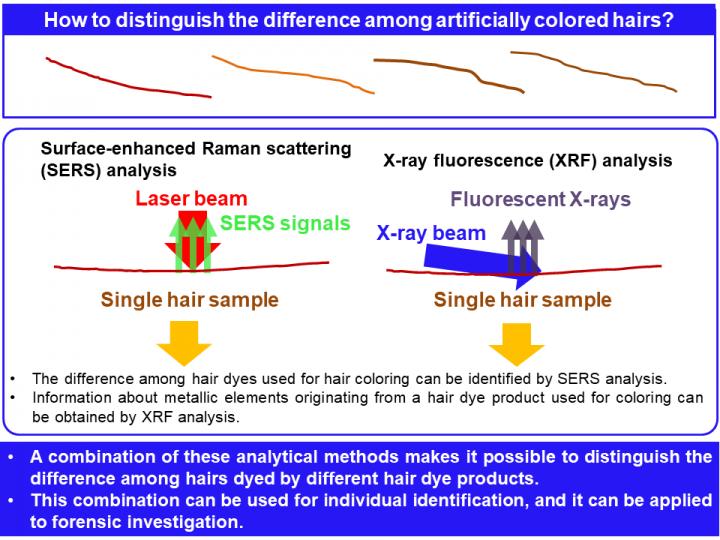Scientists develop modern analytical techniques as a tool for advancing forensic investigations

Credit: Shinsuke Kunimura from Tokyo University of Science
In crime scene investigations, a single strand of hair can make a huge difference in the evolution of a case or trial. In most cases, forensic scientists must look for clues hidden in minuscule amounts of substances or materials found at crime scenes. If a fallen strand of hair with root cells attached is found, a DNA test can reveal the identity of a criminal; unfortunately, this seldom happens. Even though other types of DNA analysis can be conducted using the “mitochondrial DNA” embedded in the hair shaft itself, such tests are not sufficient to reliably identify a person and usually call for additional evidence.
But what if a bit of fashion consciousness could inspire a new forensic technique? In a recent study published in Analytical Sciences, scientists at the Tokyo University of Science, Japan, developed a strategy for identifying criminals from a single strand of hair, leveraging the fact that hair dyes are becoming increasingly common. Their approach involves finding out if two individual strands of hair belong to the same person based on the composition of hair dye products found on them. To do this, they employed two well-known analytical methods: surface-enhanced Raman spectroscopy (SERS) and X-ray fluorescence (XRF) analysis.
Raman spectroscopy is an analytical technique based on the physical phenomenon of Raman scattering, which models certain energetic interactions that occur when photons collide with matter. SERS is a special type of Raman spectroscopy that provides a “structural fingerprint” of a material even when very few molecules are present in the target sample. On the other hand, XRF analysis involves irradiating a material with X-rays and examining the energies of photons re-emitted when the electrons in the sample leave the excited states. XRF analysis is especially useful to determine which metallic elements are present in a material.
The scientists conducted SERS and XRF analyses using portable devices to see if they could distinguish between single strands of hog hairs dyed with different products. Associate Professor Shinsuke Kunimura, who led the study, explains why both analytical methods had to be used in combination, “SERS can easily detect the overall differences in composition between different types of hair dyes, such as permanent, semi-permanent, or natural dyes. However, it is not enough to distinguish between hair coloring products that contain or produce similar dyes. To do this, we also relied on XRF analysis, which can detect the presence of metallic elements used in the ingredients of hair dye products.” Using both techniques, the scientists were able to easily distinguish between five different dyes applied to individual strands of hog hair.
Because both analytical methods used are almost non-destructive, the strategy proposed in this study could be used to quickly analyze hairs found in crime scenes on-site before they are sent for DNA analysis. “Our approach provides supportive information for more reliably identifying whose hair was found in a crime scene,” remarks first author Momona Horiguchi. “This could help us clarify if someone is a criminal, meaning that our methodology could greatly contribute to forensic investigations.”
Overall, this study showcases how analytical tools normally used in chemistry and materials science can be creatively adapted to vastly different fields, such as forensic investigations. Hopefully, in the future, it will prevent criminals from escaping by a hair’s breadth!
###
About The Tokyo University of Science
Tokyo University of Science (TUS) is a well-known and respected university, and the largest science-specialized private research university in Japan, with four campuses in central Tokyo and its suburbs and in Hokkaido. Established in 1881, the university has continually contributed to Japan’s development in science through inculcating the love for science in researchers, technicians, and educators.
With a mission of “Creating science and technology for the harmonious development of nature, human beings, and society”, TUS has undertaken a wide range of research from basic to applied science. TUS has embraced a multidisciplinary approach to research and undertaken intensive study in some of today’s most vital fields. TUS is a meritocracy where the best in science is recognized and nurtured. It is the only private university in Japan that has produced a Nobel Prize winner and the only private university in Asia to produce Nobel Prize winners within the natural sciences field.
Website: https:/
About Associate Professor Shinsuke Kunimura from Tokyo University of Science
Dr. Shinsuke Kunimura graduated in 2004 from the Faculty of Engineering at Kyoto University, Japan, where he also got a PhD in Materials Science and Engineering in 2009. He specializes in X-ray spectrometry and analytical chemistry. He has published over 30 peer-reviewed papers and received awards from The Japan Society for Analytical Chemistry and the Discussion Group of X-ray Analysis.
Media Contact
Tsutomu Shimizu
[email protected]
Original Source
https:/
Related Journal Article
http://dx.
https://scienmag.com/within-a-hairs-breadth-forensic-identification-of-single-dyed-hair-strand-now-possible/




